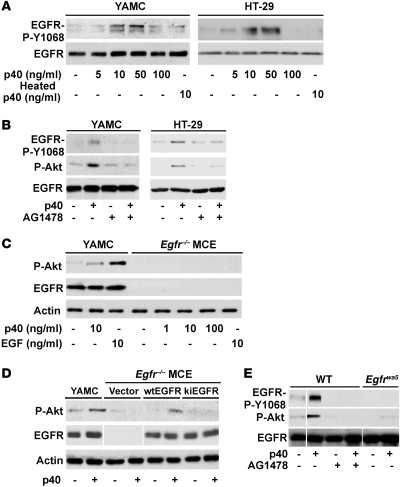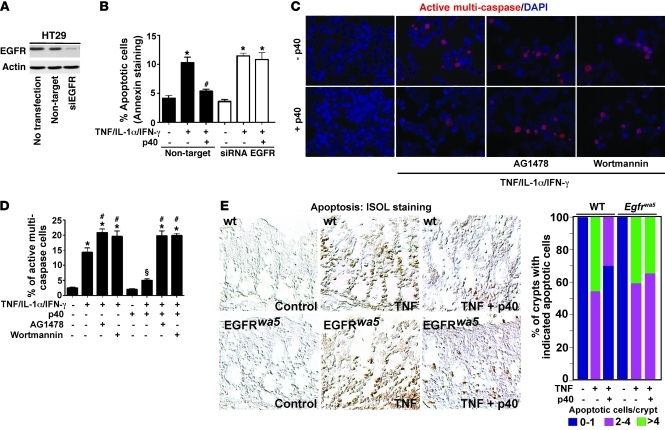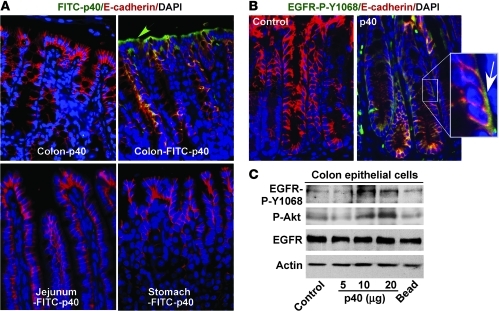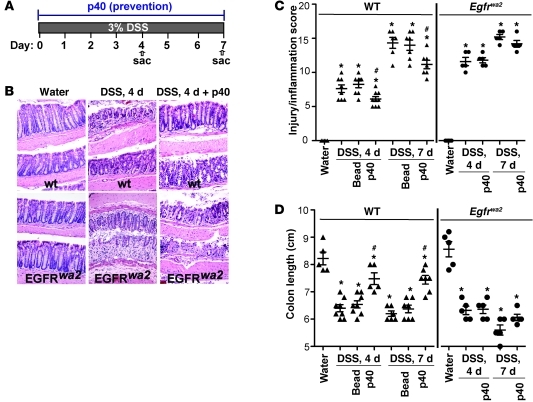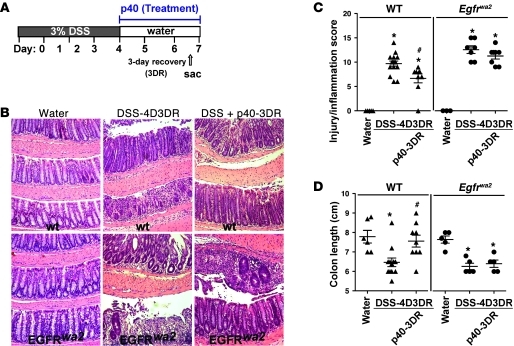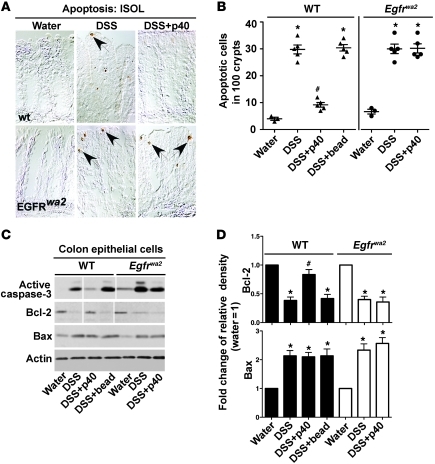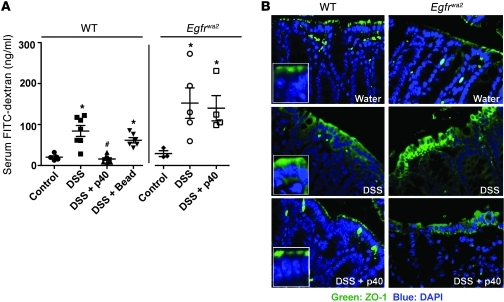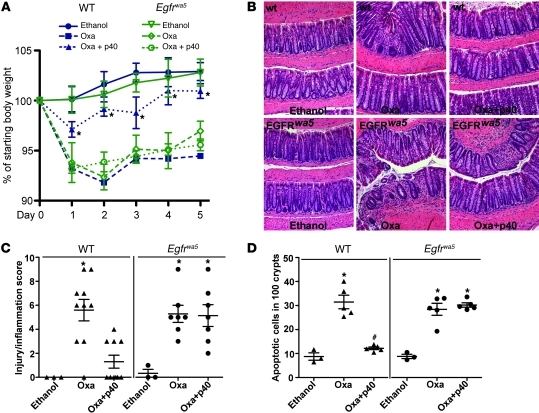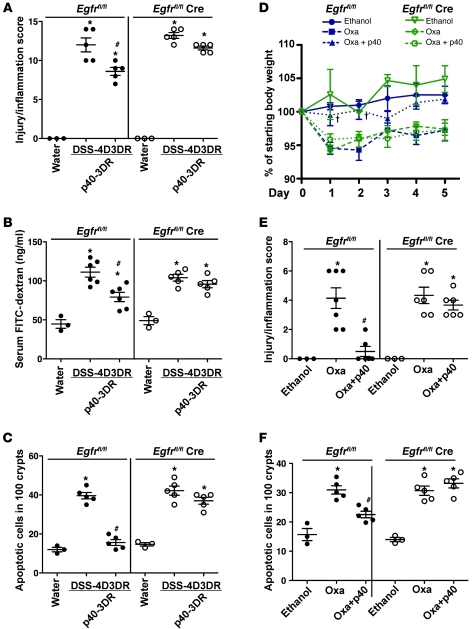Abstract
Probiotic bacteria can potentially have beneficial effects on the clinical course of several intestinal disorders, but our understanding of probiotic action is limited. We have identified a probiotic bacteria–derived soluble protein, p40, from Lactobacillus rhamnosus GG (LGG), which prevents cytokine-induced apoptosis in intestinal epithelial cells. In the current study, we analyzed the mechanisms by which p40 regulates cellular responses in intestinal epithelial cells and p40’s effects on experimental colitis using mouse models. We show that the recombinant p40 protein activated EGFR, leading to Akt activation. Activation of EGFR by p40 was required for inhibition of cytokine-induced apoptosis in intestinal epithelial cells in vitro and ex vivo. Furthermore, we developed a pectin/zein hydrogel bead system to specifically deliver p40 to the mouse colon, which activated EGFR in colon epithelial cells. Administration of p40-containing beads reduced intestinal epithelial apoptosis and disruption of barrier function in the colon epithelium in an EGFR-dependent manner, thereby preventing and treating DSS-induced intestinal injury and acute colitis. Furthermore, p40 activation of EGFR was required for ameliorating colon epithelial cell apoptosis and chronic inflammation in oxazolone-induced colitis. These data define what we believe to be a previously unrecognized mechanism of probiotic-derived soluble proteins in protecting the intestine from injury and inflammation.
Introduction
Intestinal epithelial cells actively engage in crosstalk with commensal microbiota in the intestinal tract. Interruption of these normal interactions has been linked to several pathological conditions, including inflammatory bowel disease (IBD), which consists of ulcerative colitis and Crohn disease (1). Thus, certain nonpathogenic living microorganisms, including some intestinal commensal microflora, have been used as alternative medicines for improving host health and preventing or treating various intestinal disorders. Lilly and Stillwell first described such beneficial microflora as probiotics (2). Although there has been a paucity of large and well-controlled clinical studies to evaluate the clinical efficacy of probiotics, evidence is emerging to support beneficial effects of probiotics in preventing and/or treating several intestinal diseases, including relapse of pouchitis (3) and ulcerative colitis (4, 5), diarrhea, irritable bowel syndrome, neonatal necrotizing enterocolitis, gluten intolerance, gastroenteritis, Helicobacter pylori infection, and colon cancer (6–8). The effects of probiotics on the clinical course of Crohn disease are controversial (9, 10).
Recently, three distinct and complementary cellular mechanisms for the actions of probiotics were proposed (11). First, probiotics block pathogenic bacterial effects by producing bacteriocidal substances and competing with pathogens and toxins for adherence to the intestinal epithelium. Second, probiotics regulate immune responses by enhancing innate immunity and modulating pathogen-induced inflammation via Toll-like receptor–regulated signaling pathways. Third, probiotics regulate intestinal epithelial homeostasis by promoting intestinal epithelial cell survival, barrier function, and protective responses through several signaling pathways.
The clinical application of probiotics has at least two limitations: bioavailability and biosafety. For example, bacteremia associated with probiotic therapy has been reported in very young (12) and immunocompromised patients (13). One potential approach to address these concerns may be development of probiotic bacteria–derived proteins as novel therapeutic agents. Thus, identification of probiotic-derived soluble factors that exert effects similar to those of probiotics offers not only insight into the mechanisms of probiotic action, but also significant potential for clinical application.
Lactobacillus rhamnosus GG (LGG) is a naturally occurring Gram-positive bacterium originally isolated from healthy human intestine (14).
In addition to being widely used in the production of yogurt as a nutritional supplement, LGG is one of the best-studied probiotic bacteria in clinical trials for treating and/or preventing several disorders, including diarrhea and atopic dermatitis (15). We have demonstrated that LGG prevents cytokine-induced intestinal epithelial damage and apoptosis (16, 17). Furthermore, we have identified a 40-kDa protein, p40, present in LGG culture supernatant that prevents cytokine-induced intestinal epithelial cell apoptosis by activating antiapoptotic PI3K/Akt signaling, and that protects intestinal barrier function from hydrogen peroxide–induced insults (16, 18). Other reported effects of LGG-derived soluble factors include promotion of cytoprotective pathways in intestinal epithelial cells (19) and inhibition of cytokine production in macrophages (20).
In this study, we analyze the mechanisms through which LGG p40 regulates cellular responses in intestinal epithelial cells. In addition, we evaluate p40’s role in dextran sulfate sodium–induced (DSS-induced) intestinal epithelial injury and acute colitis and oxazolone-induced Th2 cytokine–driven chronic colitis in C57BL/6 mice. We report that p40 activates EGFR, leading to amelioration of cytokine-induced apoptosis in intestinal epithelial cells. Furthermore, specific delivery of p40 to the colon prevents and treats DSS-induced colon epithelial cell injury and inflammation and ameliorates oxazolone-induced colitis in an EGFR-dependent manner. These findings provide evidence that the administration of p40 has beneficial effects on the prevention and/or treatment of intestinal inflammatory disorders.
Results
Generation of a His-tagged p40 recombinant protein.
We generated a His-tagged p40 recombinant protein (Supplemental Figure 1A; supplemental material available online with this article; doi: 10.1172/JCI44031DS1), which was recognized by both anti-p40 and anti-His antibodies (Supplemental Figure 1B). We then compared the biological activity of the purified His-tagged p40 protein with that of p40 purified from LGG culture supernatant and found that His-tagged p40 stimulated Akt activation in a concentration-dependent manner (Supplemental Figure 1C), as we previously reported for p40 purified from LGG culture supernatant (16, 17). Therefore, the p40 recombinant protein was used in all subsequent studies in this report.
p40 prevents cytokine-induced apoptosis in intestinal epithelial cells via an EGFR-dependent mechanism.
It is well known that activation of EGFR stimulates several signaling pathways, including PI3K/Akt, to promote proliferation and cell survival. Since we showed that p40 prevents cytokine-induced apoptosis in colon epithelial cells in an Akt-dependent manner (16), we investigated whether p40 activates EGFR in intestinal epithelial cells. We treated intestinal epithelial cells with recombinant p40 at various concentrations and analyzed the EGFR phosphorylation state by using Western blot analysis. p40 increased EGFR phosphorylation in young adult mouse colon (YAMC) epithelial cells and in a human colonic epithelial carcinoma cell line, HT-29 cells (Figure 1A), in a concentration-dependent manner. We chose to use p40 at a concentration of 10 ng/ml for the remainder of the cell culture studies, based on the dose-response analysis shown in Figure 1A. p40 activation of EGFR is heat-labile because heated p40 showed decreased ability to activate EGFR in YAMC and HT-29 cells (Figure 1A).
Figure 1. p40 activates EGFR, leading to Akt activation in colon epithelial cells.
(A–D) YAMC, HT-29, or Egfr–/– MCE cells were treated with p40 or heat-inactivated p40 at the indicated concentrations for 1 hour, or with EGF (10 ng/ml) for 5 minutes. (E) Colon explants derived from 6- to 8-week-old WT and Egfrwa5 mice on a C57BL/6 background were cultured in DMEM containing 0.5% FBS and treated with p40 (10 ng/ml) for 1 hour, with or without 1-hour pretreatment using an EGFR tyrosine kinase inhibitor, AG1478 (150 nM). AG1478 was maintained during the entire course of cytokine treatment. EGFR and Akt phosphorylation was detected by Western blot analysis of cellular lysates with anti–phospho-EGFR (Tyr1068) and anti–phospho-Akt (Ser473) antibodies, respectively. Anti-actin antibody was used as a loading control. In D and E, lanes were run on the same gel but were noncontiguous, as indicated by the white lines. Data in this and subsequent figures are representative of at least 5 separate experiments.
We then investigated whether p40-induced Akt activation requires EGFR by using an EGFR tyrosine kinase inhibitor and found that inhibition of EGFR kinase activity blocked the ability of p40 to stimulate Akt activation in YAMC and in HT-29 cells (Figure 1B). To confirm the role of EGFR, we used a conditionally immortalized mouse colon epithelial (MCE) cell line lacking EGFR (Egfr–/–) (21). In the absence of EGFR, p40 failed to stimulate Akt activation (Figure 1C). Importantly, expression of WT EGFR, but not kinase-inactive EGFR (kiEGFR), in Egfr–/– MCE cells rescued p40 activation of Akt (Figure 1D).
To study the kinetics of Akt activation by p40, we treated YAMC cells with p40 and EGF at the same molar concentration for 5 to 180 minutes. EGF activated EGFR from 5 to 180 minutes of treatment, with the peak activation at 5 minutes. EGF stimulated Akt activation at 5 and 30 minutes after treatment. However, at 60, 120, and 180 minutes after treatment, EGFR and Akt activation was stimulated by p40 (Supplemental Figure 2). Thus, p40 stimulates delayed EGFR and Akt activation, compared with EGF.
To define the role of EGFR kinase activity in the response to p40 in intact tissue, we treated isolated colon tissues from WT mice or Egfrwa5 mice expressing a dominant negative EGFR (22) with p40. p40 stimulated EGFR and Akt activation in colon explants isolated from WT but not Egfrwa5 mice (Figure 1E). These findings indicate that EGFR is a key regulator of p40-initiated Akt signaling in intestinal epithelial cells.
We next investigated the role of EGFR activation in p40-stimulated cytoprotection of intestinal epithelial cells from cytokine-induced apoptosis. siRNA directed against EGFR was used to reduce EGFR expression in HT-29 cells (Figure 2A). As determined by annexin V–FITC staining, p40 prevented apoptosis induced by the “cytokine cocktail” combination of TNF, IL-1α, and IFN-γ in cells transfected with nontargeting control siRNA, but failed to prevent apoptosis in cells transfected with EGFR siRNA (Figure 2B). Similarly, p40 did not inhibit the cytokine cocktail–induced caspase activation when cells were treated with the EGFR tyrosine kinase inhibitor AG1478 or the PI3K inhibitor wortmannin (Figure 2, C and D). Furthermore, p40 inhibited TNF-induced colon epithelial apoptosis in colon tissue explants from WT mice, but not Egfrwa5 colon explants (Figure 2E).
Figure 2. Activation of EGFR is required for p40-stimulated prevention of cytokine-induced apoptosis and disruption of tight junctions in colon epithelial cells.
HT-29 cells transfected with EGFR siRNA or nontargeting siRNA (A and B) for 24 hours were treated with the cytokine cocktail combination of TNF (100 ng/ml), IL-1α (10 ng/ml), and IFN-γ (100 ng/ml) for 16 hours (B). HT-29 cells were dissociated, stained with annexin V–FITC and propidium iodide, and analyzed using flow cytometry. Percentage of apoptosis is shown in B. *P < 0.01 compared with control in non-target or EGFR siRNA–transfected cells; #P < 0.01 compared with TNF/IL-1α/IFN-γ treatment in non-target siRNA–transfected cells. HT-29 cells were treated with the cytokine cocktail as indicated in B for 8 hours, with or without 1-hour pretreatment using AG1478 (150 nM) or wortmannin (100 nM). (C) Caspase activity in living cells was detected using the Sulforhodamine Multi-Caspase Activity Kit, with caspase-active cells staining red. The percentage of cells with active caspase is shown in D.*P < 0.01 compared with control; #P < 0.05 and §P < 0.01 compared with TNF/IL-1α/IFN-γ treatment. Colon explants derived from 6- to 8-week-old mice were cultured in DMEM containing 0.5% FBS and treated with TNF (100 ng/ml) for 8 hours in the presence or absence of p40 (10 ng/ml). (E) Paraffin-embedded tissue sections were prepared for detecting apoptosis using ISOL staining. Apoptotic nuclei (brown nuclei) labeled with peroxidase were visualized using differential interference contrast (DIC) microcopy. The percentage of crypts with apoptotic cells is shown. n = 3 mice for each group. Three colon explants were cultured from each mouse for each treatment condition. Original magnification, ×20 (C); ×40 (E).
Thus, in human intestinal epithelial cell lines and cultured mouse colon explants, activation of EGFR is required for p40-stimulated prevention of cytokine-induced apoptosis.
Specific delivery of p40 to the colon stimulates EGFR activation in colon epithelial cells in vivo.
In order to study the role of p40 in colitis in vivo, a delivery system resistant to proteases, acid, and other intestinal contents is required. Among many approaches for oral delivery of drugs to the colon, pectin/zein-based hydrogel beads show considerable promise (23, 24). Pectin is a natural polysaccharide, derived from vegetables and fruit, that is degraded in the colon by colonic microflora–produced pectinolytic enzymes and not readily digested by gastric or small intestinal enzymes. In addition, the hydrophobic nature of zein protects drugs from gastric acid. Zein is released in the small intestine by protease digestion. We prepared pectin/zein beads containing p40 (5 μg/bead) with an average diameter of 2 mm. Beads were administered to mice through gavage, and mice were sacrificed after a 4-hour treatment. The whole colon, three parts of the small intestine, the duodenum, jejunum, and ileum, and the stomach were examined. We found FITC-p40 on the surface of the whole colon epithelium, with more p40 recovered in the proximal and middle parts of the colon (Figure 3A and Supplemental Figure 3), but no p40 was found in the duodenum, jejunum, or stomach (Figure 3A). Limited amounts of p40 were found in the ileum (data not shown). Immunostaining showed that treatment with p40-containing beads increased EGFR phosphorylation in cells staining positive for E-cadherin (an epithelial cell adherens junctional marker), indicating that p40 stimulated EGFR activation in colon epithelial cells (Figure 3B). To confirm this observation, we isolated colon epithelial cells for Western blot analysis. EGFR and Akt were activated in colon epithelial cells isolated from mice treated with beads containing p40, but not in cells from mice treated with control beads (Figure 3C). Treatment with 10 μg p40 stimulated maximal EGFR activation compared with other p40 dosages that we tested. Thus, we chose this dosage for subsequent experiments in this study.
Figure 3. Delivery of p40 to the colon using pectin/zein hydrogel beads activates EGFR in colon epithelial cells.
Pectin/zein beads containing p40 or FITC-labeled p40 (10 μg p40 in A and B, or at the indicated doses in C), or pectin/zein beads only without p40 (control) were administered to WT C57BL/6 mice by gavage. Mice were sacrificed 4 hours after gavage. Paraffin-embedded tissue sections were prepared for immunohistochemistry to detect p40 delivery (green staining) (A), EGFR activation using a rabbit anti–phospho-EGFR (Tyr1068) antibody and FITC-conjugated secondary antibody (green staining) (B), an epithelial cell marker using a mouse anti–E-cadherin antibody and Cy3-conjugated secondary antibody (red staining) (A and B), and nuclei using DAPI staining (blue staining) (A and B). The green arrow in A indicates FITC-p40 detected in the intestine. The white arrow in B indicates EGFR-Tyr1068 phosphorylation in cells staining positively for E-cadherin. Original magnification, ×40 (A and B); ×60 (B, inset). (C) Colon epithelial cells were isolated for Western blot analysis to detect EGFR and Akt activation as described in Figure 1.
p40 prevents and treats DSS-induced acute colitis in an EGFR-dependent manner.
Since the well-characterized DSS mouse model of acute colitis is characterized by increased epithelial injury and production of inflammatory cytokines (25, 26), we investigated the preventive and therapeutic effects of p40 on DSS-induced colon epithelial injury and colitis in vivo. To evaluate the ability of p40 to prevent colitis, we administered p40 at the beginning of DSS treatment until mice were sacrificed (Figure 4A). DSS treatment for 4 or 7 days induced injury and acute colitis with massive colon ulceration, crypt damage, and severe inflammation. These abnormalities were reduced by cotreatment with p40-containing beads in WT mice, but not in Egfrwa2 mice with kinase-defective EGFR (Figure 4B). Colon epithelial injury and inflammation were scored by a pathologist blinded to the treatment. Administration of DSS to WT mice induced severe colitis (scores, 7.6 ± 1.6 and 14.3 ± 2.0 after 4 and 7 days of DSS treatment, respectively). p40 treatment significantly decreased injury and inflammation (scores, 6.1 ± 1.1, P < 0.05, and 11.1 ± 1.7, P < 0.01, after 4 and 7 days of DSS treatment, respectively). Administration of beads alone (without p40) had no effect on DSS-induced colitis (scores, 8.3 ± 1.4 and 13.4 ± 2.1 after 4 and 7 days of DSS treatment) (Figure 4C). DSS-induced shortening of the colon, a marker for colitis, was prevented by p40-containing beads, but not beads only (Figure 4D). In contrast to what was observed in WT mice, treatment with p40-containing beads did not ameliorate injury or inflammation scores and shortening of colon length in Egfrwa2 (Figure 4, B–D) or Egfrwa5 mice (data not shown).
Figure 4. p40 prevents DSS-induced colitis in mice.
(A) Mice were treated with 3% DSS in drinking water for 4 or 7 days and were gavaged with pectin/zein control beads or beads containing p40 at 10 μg/mouse/d, beginning on the same day of DSS treatment until the end of the experiment. Control mice received water alone. sac, sacrifice. (B) Paraffin-embedded colon sections were stained with H&E for light microscopic assessment of epithelial damage. Original magnification, ×10. (C) Colon injury scores are shown. (D) The length of colon was measured. *P < 0.05 compared with water groups in WT or Egfrwa2 mice; #P < 0.05 compared with either WT mice treated with DSS or WT mice treated with DSS and control beads.
To evaluate the ability of p40 to ameliorate established colitis (treatment effect), we treated mice with DSS for 4 days to induce colitis and then administered p40 via gavage for the following 3 days before mice were sacrificed (Figure 5A). In established DSS-induced colitis (score, 9.7 ± 2.1), injury and inflammation were significantly decreased following treatment with p40 (score, 6.7 ± 2.7, P < 0.05) in WT mice (Figure 5, B and C). In Egfrwa2 mice, p40 failed to reduce DSS-induced inflammation. In addition, p40 treatment significantly reduced DSS-induced colon shortening in WT mice, but not in Egfrwa2 (Figure 5D) or in Egfrwa5 mice (data not shown). These data suggest that p40 exerts both preventive and therapeutic effects on intestinal epithelial cell injury associated with colitis in an EGFR-dependent manner.
Figure 5. p40 treats DSS-induced colitis in mice.
(A) Colitis was induced by 3% DSS treatment for 4 days, and then mice were administered p40 for the following 3 days before mice were sacrificed. Control mice received water alone. 3DR, 3-day recovery. (B) Paraffin-embedded colon sections were stained with H&E for light microscopic assessment of epithelial damage. Original magnification, ×10. (C) Colon injury scores are shown. (D) The length of colon was measured. *P < 0.05 compared with water groups in WT or Egfrwa2 mice; #P < 0.05 compared with WT mice treated either with DSS or with DSS and control beads. DSS-4D3DR, mice treated with DSS for 4 days and sacrificed 3 days after recovery with water; p40-3DR, mice administered p40 for the 3-day recovery period.
EGFR kinase activity is required for p40-stimulated antiapoptotic and barrier-preserving effects in DSS-induced colitis.
Since p40 prevents cytokine-induced colon epithelial cell apoptosis through activation of EGFR (Figure 2), we next determined whether p40 reduced DSS-induced colon epithelial cell apoptosis and barrier disruption and whether these protective effects required EGFR activity.
DSS-induced colon epithelial cell apoptosis, detected using an In Situ Oligo Ligation (ISOL) kit, was inhibited by preventive administration of p40 in WT, but not Egfrwa2, mice (Figure 6, A and B). Similarly, Western blot analysis of colon epithelial cell lysates showed that DSS-induced caspase-3 activation was inhibited by p40 in WT, but not Egfrwa2, mice (Figure 6C). Since EGFR has direct effects on the apoptotic machinery through regulating expression of several factors, including an antiapoptotic protein, Bcl-2, and a proapoptotic protein, Bax (27), we studied expression of these proteins in colon epithelial cells. DSS induced downregulation of Bcl-2 expression, and this effect was blocked by p40 in WT mice, but not in Egfrwa2 mice (Figure 6, C and D). However, p40 did not have any detectable effect on DSS-induced upregulation of Bax (Figure 6, C and D). Thus, these results suggest that p40 activation of EGFR regulates Bcl-2 expression in colon epithelial cells in DSS-treated mice. Since Bcl-2 is a known antiapoptotic protein (27), p40 regulation of Bcl-2 expression through EGFR activation might mediate p40’s prevention of apoptosis in DSS-induced colitis.
Figure 6. EGFR kinase activity is required for p40-mediated inhibition of DSS-induced colon epithelial cell apoptosis.
(A) Mice were treated with DSS for 7 days and were gavaged with pectin/zein beads only or beads containing p40 at 10 μg/mouse/d, beginning on the same day of DSS treatment until the end of the experiment, as described in Figure 4. Paraffin-embedded tissue sections were analyzed using ISOL staining to detect apoptosis. Apoptotic nuclei labeled with peroxidase were visualized using DIC microcopy. Arrows indicate ISOL-labeled apoptotic nuclei (brown). Original magnification, ×40. (B) The number of apoptotic nuclei per 100 crypts is shown. (C) Colon epithelial cells were isolated for Western blot analysis to detect active caspase-3, Bcl-2, and Bax expression. The lanes in C were run on the same gel but were noncontiguous, as indicated by the white lines. (D) The relative densities of protein bands on Western blots were determined by comparing densities of active caspase-3, Bcl-2, or Bax to that of the actin bands. The relative density of bands from the control (water-treated) group was set as 100%, and the relative densities of bands from DSS-treated mice were compared with those in the water-treated group. n = 5–7 mice for each condition. *P < 0.01 compared with water groups in WT or Egfrwa2 mice; #P < 0.01 compared with either WT mice treated with DSS or WT mice treated with DSS and control beads.
To further characterize effects of p40 on DSS-induced disruption of intestinal integrity, we performed an in vivo permeability assay to test intestinal barrier function. Disrupted barrier function, as evidenced by increased FITC-dextran in the serum, was found in both DSS-treated WT mice and Egfrwa2 mice. Treatment with p40 prevented DSS-induced changes in colon permeability in WT mice, but not Egfrwa2 mice (Figure 7A). As a marker of tight junction structure, we determined the distribution of a tight junctional protein, zona occludens 1 (ZO-1), using immunostaining. DSS-induced redistribution of this protein from apical tight junctional complexes to the cytoplasmic compartment of colon epithelial cells was prevented by p40 treatment in WT, but not in Egfrwa2, mice (Figure 7B).
Figure 7. EGFR kinase activity is required for p40 to prevent DSS-induced disruption of intestinal barrier function.
(A) Mice were treated with DSS for 7 days with or without p40-containing pectin/zein bead cotreatment, as described in Figure 5. Intestinal permeability was determined by rectal administration of FITC-dextran on the sixth day of DSS treatment. FITC-dextran level in sera is shown. (B) Paraffin-embedded colon tissues were used to determine ZO-1 distribution by immunohistochemistry using an anti–ZO-1 antibody and FITC-labeled secondary antibody and visualized using fluorescence microcopy (green staining). Nuclei were stained with DAPI (blue staining). *P < 0.01 compared with water groups in WT or Egfrwa2 mice; #P < 0.01 compared with either WT mice treated with DSS or WT mice treated with DSS and control beads. Original magnification, ×20; ×60 (insets).
We also found that p40 reduced DSS-induced intestinal epithelial cell apoptosis (Supplemental Figure 4) and disruption of intestinal integrity (Supplemental Figure 5) when p40 was administered as a treatment for colitis in WT, but not in Egfrwa2, mice. Thus, the cytoprotective effects of p40 during colitis appear to be mediated by EGFR, a previously reported therapeutic target for treatment of human colitis (28).
p40 ameliorates oxazolone-induced chronic colitis in WT, but not Egfrwa5, C57BL/6 mice.
The haptenating agent oxazolone has been reported to induce Th2 cytokine–driven (IL-4 and IL-5) colitis in the distal colon in mice with increased IL-13 production. The histological features in this model resemble ulcerative colitis, but not Crohn disease (29, 30). In addition, ulcerative colitis is suggested to be mediated by increased Th2 cytokine production, although IL-4 is not increased in this disease (31). Since it has been shown that oxazolone presensitization followed by intrarectal administration elicits chronic inflammatory responses in C57BL/6 mice (29, 30), we sought to determine the role of p40 in resolution of colitis in this model. WT and Egfrwa5 mice on the C57BL/6 background were gavaged with p40 beginning on the same day of intrarectal oxazolone administration, until mice were sacrificed. p40 treatment, compared with no treatment, prevented body weight loss in WT but not Egfrwa5 mice (Figure 8A). In addition, oxazolone-induced histological changes, including the disruption of epithelial monolayer and inflammatory cell infiltration (score, 5.6 ± 2.84) were relieved by p40 treatment (score, 1.3 ± 1.70) in WT mice (Figure 8, B and C). We did not find significant changes in intestinal epithelial cell proliferation, FITC-dextran levels in the serum, or distribution of ZO-1 protein in the colon epithelium in oxazolone-treated WT mice, compared with ethanol-treated control mice. However, increased colon epithelial cell apoptosis by oxazolone in WT mice was inhibited by p40 (Figure 8D). p40 treatment did not show any effects on reducing oxazolone-induced colitis and epithelial apoptosis in Egfrwa5 mice (Figure 8, A–D). The same results were found in Egfrwa2 mice (data not shown). Thus, these data suggest that p40 activates EGFR to exert beneficial effects on Th2-driven colitis.
Figure 8. EGFR kinase activity mediates p40 amelioration of oxazolone-induced colitis in mice.
(A) Mice were presensitized with oxazolone. Then oxazolone (Oxa) was administered rectally in the presence or absence of gavage with p40-containing beads at 10 μg/mouse/d, beginning on the day of rectal oxazolone administration until the end of the experiment. Mice were sacrificed 5 days after intrarectal challenge with oxazolone. Control mice received ethanol only. Body weight changes after intrarectal challenge with ethanol or oxazolone are shown. *P < 0.05 compared with WT mice on the same day of oxazolone treatment. (B) Paraffin-embedded colon sections were stained with H&E for light microscopic assessment of epithelial damage. Original magnification, ×10. (C) Colon injury scores are shown. (D) Paraffin-embedded tissue sections were analyzed using ISOL staining to detect apoptosis, as described in Figure 5. The number of apoptotic nuclei per 100 crypts is shown. In C and D, *P < 0.01 compared with ethanol groups in WT or Egfrwa5 mice; #P < 0.05 compared with oxazolone group in WT mice.
EGFR expression in the intestinal epithelium is required for p40’s beneficial effects on colitis.
It is important to determine the role of intestinal epithelial cell EGFR in p40-mediated colitis prevention and treatment. To generate mice with EGFR specifically deleted in the intestinal epithelial cells, we crossed Egfrfl/fl mice with villin-Cre mice to generate transgenic mice with constitutive deletion of EGF receptor in the intestinal epithelial cells (Egfrfl/fl-Cre, Supplemental Figure 6). Their littermates, Egfrfl/fl mice, were used as control mice.
The effects of p40 on DSS-induced colitis were tested in these mice. In established DSS-induced colitis, injury and inflammation were significantly decreased by p40 treatment in Egfrfl/fl mice (Figure 9A). In Egfrfl/fl-Cre mice, p40 failed to reduce DSS-induced inflammation (Figure 9A). DSS-induced disrupted colonic barrier function, as determined by increased FITC-dextran in the serum, and colonic epithelial cell apoptosis were inhibited by administration of p40 in Egfrfl/fl, but not in Egfrfl/fl-Cre, mice (Figure 9, B and C). We also found that p40 did not prevent 7-day DSS-induced body weight loss, inflammation, and shortening of colon length in Egfrfl/fl-Cre mice (Supplemental Figure 7).
Figure 9. Intestinal epithelial expression of EGFR is required for p40’s effects on colitis.
Mice were treated with 3% DSS treatment for 4 days, and then mice were administered p40 for the following 3 days before mice were sacrificed to test p40’s treatment effect, as described in Figure 5. To test the effects of p40 on oxazolone-induced colitis, mice were administered oxazolone and p40, as described in Figure 8. (A and E) Colon injury scores. (D) Body weight changes after intrarectal challenge of ethanol or oxazolone. (C and F) Apoptosis was detected as described in Figure 6. The number of apoptotic nuclei per 100 crypts is shown. (B) Intestinal permeability was determined as described in Figure 7. FITC-dextran level in sera is shown. *P < 0.01 compared with water or ethanol group in Egfrfl/fl mice; #P < 0.05 compared with DSS or oxazolone group in WT mice; †P < 0.05 compared with WT mice on the same day of oxazolone treatment.
In addition to DSS-induced colitis, the effects of p40 on oxazolone-induced colitis were determined. p40 did not prevent body weight loss, inflammation, and epithelial apoptosis induced by oxazolone in Egfrfl/fl-Cre mice, compared with Egfrfl/fl littermate controls (Figure 9, D–F). Thus, these data suggested that p40 transactivation of EGF receptor in the intestinal epithelium plays a protective role in intestinal inflammatory disorders.
Discussion
In the present study, we demonstrate that the LGG-derived soluble protein p40 activates EGFR in vivo and in vitro in colon epithelial cells. Activation of EGFR by p40 is required for inhibition of cytokine-induced apoptosis and disruption of barrier integrity in intestinal epithelial cells in vitro and ex vivo. Importantly, p40 prevents and treats DSS-induced colon epithelial injury and inflammation and ameliorates oxazolone-induced colitis, and it mediates reductions of intestinal epithelial apoptosis and disruption of barrier function in these two mouse models, in an EGFR activation-dependent manner. Therefore, our findings provide a rationale for conducting new hypothesis-driven studies to define the clinical efficacy of probiotic-derived proteins in preventive, adjunctive, or alternative treatments for intestinal inflammatory disorders.
Understanding p40’s structure-function relationship is critical to elucidate the biological effects of this protein. Sequence analysis of p40 predicts that the N-terminal portion forms a coiled-coil structure and the C-terminal portion forms a β-sheet structure. Therefore, we expressed the N-terminal 1–180 aa and the C-terminal portion (aa 181–412) of p40 as recombinant peptides (Supplemental Figure 8A). We found that the p40 N-terminal peptide is sufficient to stimulate EGFR and Akt activation in intestinal epithelial cells and prevent DSS-induced colitis. However, the C-terminal portion of p40 had no effect on EGFR and Akt activation and DSS-induced colitis (Supplemental Figure 8, B and C). These data suggest that the p40 functional domain(s) localize to the N-terminal 1–180 aa.
A major finding of our report is that activation of EGFR in intestinal epithelial cells mediates the protective action of the probiotic-derived p40 protein (Figure 9 and Supplemental Figure 7). However, how p40 activates EGFR in intestinal epithelial cells remains to be determined. EGFR can be activated by direct ligand binding (such as EGF, heparin-binding EGF [HB-EGF], TGF-α, and amphiregulin [AR]) to the extracellular domain of the EGF receptor to trigger activation of EGFR (32, 33). EGFR ligands are synthesized as transmembrane precursors that are cleaved to release biologically active soluble growth factors, which act in an autocrine and/or paracrine manner (34). Release of EGFR ligands is a highly regulated process and can be activated by a wide variety of pharmacological and physiological stimuli, including ligand-mediated stimulation of receptor tyrosine kinases, G protein–coupled receptors, and cytokine receptors (35–37). These extracellular signals activate intracellular mediators, including Src, leading to metalloproteinase-dependent ligand release (38, 39). Alternatively, activated Src, a non-receptor tyrosine kinase, is able to directly phosphorylate the EGF receptor (40). These two mechanisms of EGFR activation are not mutually exclusive and may occur simultaneously. Our unpublished observations suggest that p40-induced activation of EGFR requires both Src and metalloproteinase activities to release ligands of EGFR in intestinal epithelial cells. Identification of the specific EGFR ligands released upon p40 treatment is an ongoing area of investigation.
A number of disorders of the gastrointestinal tract, including IBD, are characterized by elevated cytokine production and increased apoptosis, which disrupt the integrity of the protective epithelial monolayer. Therefore, strategies that promote maintenance of intestinal epithelial integrity may serve as effective approaches for treatment of IBD and other cytokine-mediated intestinal disorders. Previous studies have revealed the importance of growth factors such as EGF in maintaining intestinal health and serving as potential therapeutic approaches to induce restitution of the damaged epithelium. Blocking the expression of three EGFR ligands (EGF, TGF-α, and AR) induces spontaneous duodenal ulcers and perforation (41), while loss of EGFR activity increases susceptibility to colitis (42). Further support for a role of EGFR signaling in colitis is shown by the observation that overexpression of TGF-α protects mice from DSS-induced colitis (43). Importantly, administration of EGF through enemas induced remission in patients with ulcerative colitis (28). Our studies further suggest the protective role of activation of EGFR in the intestinal epithelium in colitis by the finding that p40 fails to ameliorate DSS- and oxazolone-induced colitis in Egfrfl/fl-Cre mice with EGFR specifically deleted in the intestinal epithelium (Figure 9 and Supplemental Figure 7). Interestingly, a recently reported study found that MyD88 signaling–mediated EGR ligand production in nonhematopoietic cells protected mice against DSS-induced colitis (44). Our findings, together with these previous reports, suggest that activation of EGFR may play a significant role in the action of probiotic bacteria in promoting intestinal epithelial homeostasis and barrier integrity.
However, it should be noted that aberrant EGFR activation due to overexpression and/or mutation of EGFR and autocrine growth factor loops have been related to hyperproliferative diseases such as cancer. Thus, one concern regarding probiotic therapy in IBD is an increased risk of cancer. The potential effects of p40-induced EGFR activation on tumorigenesis, especially when p40 is administered for long time periods, are under investigation in our laboratory.
In addition to regulation of intestinal epithelial homeostasis, probiotics have been reported to modulate immune responses in several diseases, including colitis (7, 11, 45). Our additional data show that p40 treatment reduces production of TNF, IL-6, keratinocyte chemoattractant (KC), and IFN-γ, but not IL-1β, IL-10, and IL-17 in DSS-treated mice (Supplemental Figures 9 and 10). Importantly, p40 treatment resulted in decreased influx of macrophages and polymorphonuclear cells (PMNs), but not lymphocytes, into the colonic mucosa during DSS colitis (Supplemental Figure 9). However, p40 treatment did not affect IL-13 (Supplemental Figure 11) production in oxazolone-treated mice. Interestingly, we found that p40 treatment is associated with decreasing IFN-γ and TNF production in the 2,6,4-trinitrobenzenesulfonic acid (TNBS) model (data not shown).
Since macrophage-produced TNF, IL-6, and KC are involved in innate immunity (46), TNF and IFN-γ mediated Th1 responses, IL-13 is a cytokine-mediated Th2 response (47), it is possible that p40 plays a role in regulation of innate immunity and Th1 immune response. This hypothesis is supported by our other finding that p40 decreases TNF production in macrophages isolated from the colon of DSS-treated mice (Supplemental Figure 9B).
We are focusing on determining the mechanisms by which p40 regulates innate immunity. It has been reported that LGG-conditioned cell culture media decreases TNF production in macrophages, indicating that soluble molecules derived from LGG exert this immunoregulatory role (20). Therefore, we hypothesize that p40 may have direct effects on macrophages and/or lymphocytes to regulate immune responses during inflammation. This hypothesis is being tested in our laboratory.
Analysis of the known genomic sequences of Lactobacillus strains (L. plantarum, L. acidophilus NCFM, L. johnsonii NCC 533, and L. sakei) has revealed a large number of predicted secreted and cell-surface proteins that can potentially have regulatory effects on intestinal cells (48–50). However, the potential in vivo effects of such proteins on host health and disease prevention and/or treatment have not yet been investigated. Although the LGG genome is unpublished, some LGG-produced soluble factors have been studied. LGG has been reported to secrete low-molecular-weight factors (<10 kDa) to stimulate cytoprotective heat shock protein production by intestinal epithelial cells (19). Studies of immune functions show that factors in LGG culture supernatant inhibit lipopolysaccharide- or Helicobacter pylori–stimulated cytokine production in macrophages (20) and decrease enterotoxigenic E. coli–induced chemokine and cytokine expression in intestinal Caco-2 cells (51). In addition to p40, we have purified and cloned another protein, p75, from LGG culture supernatant (16). Although both p40 and p75 are able to prevent cytokine-induced apoptosis, p40 appears more potent than p75 (our unpublished observations). It is likely that additional factors secreted by LGG and other probiotic bacteria may have cytoprotective or immunological effects in the gastrointestinal tract or other tissues, and thus this field represents an important area for further investigation.
This is the first report to our knowledge showing delivery of probiotic-derived soluble proteins to the colon to protect mice from colitis. This effect is mediated through activation of EGFR and supports development of probiotic-derived proteins as novel reagents for preventing and/or treating ulcerative intestinal inflammatory disorders.
Methods
Methods for generation of p40 recombinant protein, FITC labeling of p40, cellular lysate preparation, Western blot analysis, immunohistochemistry, cell culture, and colon inflammation assessment are supplied in Supplemental Methods.
Cell culture and transfection.
YAMC and Egfr–/– MCE cells were isolated from the colonic epithelium of H-2Kb-tsA58 mice (Immortomouse) (52) and Egfr-null heterozygous mice crossed with the Immortomouse (21), respectively. Egfr–/– MCE cells were stably transfected with pcDNA3.1/Zeo vector control, pcDNA3.1/Zeo/wtEGFR, or pcDNA3.1/Zeo/kiEGFR (K721R), which blocks ATP binding, as described previously (53). Stable pools of cells expressing EGFR were maintained in medium containing 200 μg/ml zeocin.
The HT-29 human colonic epithelial carcinoma cells were transiently transfected with either nontargeting siRNA or mouse EGFR SMARTpool (Dharmacon) siRNA at 70% confluence for 24 hours using Lipofectamine 2000 according to the manufacturer’s instructions (Invitrogen).
Preparation of pectin/zein hydrogel beads.
The pectin/zein beads were prepared according to previously published methods (23). p40 recombinant protein with or without FITC labeling was dissolved in pectin solution (6% w/v) in water. Zein solution (1% w/v) was prepared in 85% ethanol solution containing 0.5% (w/v) CaCl2. Then, the pectin solution at room temperature was dropped into the zein solution through a 23G needle connected to a syringe. After drops (50 μl/drop) became solid in zein solution, the beads were washed with water, air dried at room temperature, and stored at 4°C. Beads with an average size of 2 mm contained 5 μg p40/bead. As negative controls, pectin/zein beads without p40 were prepared.
Mice and treatment.
All animal experiments were performed according to protocols approved by the Institutional Animal Care and Use Committee of Vanderbilt University. Egfrfl/fl mice on a C57BL/6 background were crossed with villin-Cre mice on a C57BL/6 background to generate constitutive intestinal epithelium–specific Egfr-knockout (Egfrfl/fl-Cre) mice. Their littermate Egfrfl/fl mice were used as controls. C57BL/6 WT as well as Egfrwa5 (EGFR dominant negative) (22) and Egfrwa2 (EGFR kinase–defective) (54) mice on a C57BL/6 background were also used for this study.
Eight- to 12-week old mice were gavaged with pectin/zein beads containing p40 or FITC-labeled p40 or pectin/zein control beads for 4 hours before sacrifice to detect the presence of p40 in the intestinal tract and EGFR activation in colon epithelial cells.
To analyze the role of p40 in preventing DSS-induced acute colitis, we administered 3% DSS (molecular weight, 36–50 kDa) to mice in drinking water for 4 or 7 days. Mice were gavaged with beads with or without p40, beginning on the same day of DSS treatment, until they were sacrificed for detection of p40’s preventive effects on colitis. To evaluate p40’s treatment effect on DSS-induced colitis, after colitis was induced by 3% DSS treatment for 4 days, we administered p40 to for the following 3 days before sacrificing the mice. Mice were fed with drinking water as control. Colon tissue was used for isolation of colon epithelial cells and for preparation of paraffin-embedded tissue sections.
To evaluate the role of p40 in oxazolone-induced colitis, we presensitized mice by applying 200 μl of 3% (w/v) oxazolone in 100% ethanol onto a 2 × 2–cm area of shaved skin. After 5 days of presensitization, mice were treated with 150 μl of 1.5% (w/v) oxazolone in 50% ethanol intrarectally. Ethanol only was used as control. Mice were sacrificed after 5 days of oxazolone rechallenge. Mice were gavaged with p40 (10 μg/mouse/d), beginning on the same day of intrarectal oxazolone treatment, until sacrifice.
Intestinal permeability assay.
FITC-conjugated dextran dissolved in water (4,000 MW) was administered rectally to mice at 2 mg/10 g body weight. Whole blood was collected using heparinized microhematocrit capillary tubes via eye bleed 2 hours after FITC-dextran administration. Fluorescence intensity in sera was analyzed using a plate reader. The concentration of FITC-dextran in sera was determined by comparison to the FITC-dextran standard curve.
Isolation of colon epithelial cells from mice.
MCE cells were isolated using a modified protocol (55). The colon was opened and incubated with 0.5 mM dithiothreitol and 3 mM EDTA at room temperature for 1.5 hours without shaking. After gently removing the solution, PBS was added to the colon. Crypts released from the colon by shaking the tubes were washed with PBS by centrifuging and then were solubilized in cell lysis buffer.
Mouse colon organ culture.
Colon explants obtained from 6- to 8-week-old WT C57BL/6 and Egfrwa5 (EGFR dominant negative) (22) mice on a C57BL/6 background were used for organ culture, as described previously (16). Briefly, the colon explants were cultured on Netwell inserts in DMEM containing 0.5% FBS at 37°C with 5% CO2 for 2 hours before treatment. At the end of the experiment, colon tissue was lysed in homogenization buffer (56) or fixed in 4% paraformaldehyde at 4°C overnight before preparation of paraffin-embedded tissue sections.
Apoptosis assays.
Apoptosis was detected in colon tissue sections by using the ApopTag ISOL Kit (Millipore) and T4 DNA ligase according to the manufacturer’s guidelines, or by using anti–active caspase-3 antibody staining and reagents provided in the Vectastain ABC kit (Vector Laboratories), as previously reported (16, 53). We determined the absolute number of positive-stained apoptotic cells in at least 300 colonic crypts.
Apoptosis in cell lines was detected by two methods. Annexin V–FITC staining was performed according to the manufacturer’s instructions (Calbiochem/EMD Biosciences), as described previously (16). Attached cells were dissociated using Accutase (Innovative Cell Technologies) and double stained with annexin V–FITC and propidium iodide for flow cytometry analysis. Active caspases in living cultured cells were labeled with cell-permeable sulforhodamine-conjugated valyl-alanyl-aspartic acid fluoromethyl ketone supplied in the Sulforhodamine Multi-Caspase Activity Kit (Biomol International), following the manufacturer’s instructions. Cells were then fixed, mounted, and observed using fluorescence microscopy.
Statistics.
Statistical significance for multiple comparisons in each study was determined by 1-way ANOVA followed by Newman-Keuls analysis using Prism 5.0 (GraphPad Software). A P value less than 0.05 was considered significant. All data presented are representative of at least 5 repeat experiments and are presented as mean ± SEM.
Supplementary Material
Acknowledgments
This work was supported by NIH grants DK065744 and DK081134 and a Crohn’s and Colitis Foundation of America Senior Research Award (to F. Yan); DK56008 (to D.B. Polk); AT004821, AT004821-S1, and DK053620 (to K.T. Wilson); the Department of Veterans Affairs (to T.L. Cover and K.T. Wilson); P30DK058404 (Vanderbilt University Digestive Disease Research Center); and CA 68485 (Vanderbilt University Medical Center Imaging Core Research Laboratory).
Footnotes
Conflict of interest: The authors have declared that no conflict of interest exists.
Citation for this article: J Clin Invest. 2011;121(6):2242–2253. doi:10.1172/JCI44031.
D. Brent Polk’s present address is: Department of Pediatrics, University of Southern California and Children’s Hospital Los Angeles, Los Angeles, California, USA.
See the related Commentary beginning on page 2149.
References
- 1.Strober W, Fuss I, Mannon P. The fundamental basis of inflammatory bowel disease. J Clin Invest. 2007;117(3):514–521. doi: 10.1172/JCI30587. [DOI] [PMC free article] [PubMed] [Google Scholar]
- 2.Lilly DM, Stillwell RH. Probiotics: growth-promoting factors produced by microorganisms. Science. 1965;147:747–748. doi: 10.1126/science.147.3659.747. [DOI] [PubMed] [Google Scholar]
- 3.Gionchetti P, et al. Prophylaxis of pouchitis onset with probiotic therapy: a double-blind, placebo-controlled trial. Gastroenterology. 2003;124(5):1202–1209. doi: 10.1016/S0016-5085(03)00171-9. [DOI] [PubMed] [Google Scholar]
- 4.Bibiloni R, et al. VSL#3 probiotic-mixture induces remission in patients with active ulcerative colitis. Am J Gastroenterol. 2005;100(7):1539–1546. doi: 10.1111/j.1572-0241.2005.41794.x. [DOI] [PubMed] [Google Scholar]
- 5.Kato K, et al. Randomized placebo-controlled trial assessing the effect of bifidobacteria-fermented milk on active ulcerative colitis. Aliment Pharmacol Ther. 2004;20(10):1133–1141. doi: 10.1111/j.1365-2036.2004.02268.x. [DOI] [PubMed] [Google Scholar]
- 6.Walker W, Goulet O, Morelli L, Antoine J. Progress in the science of probiotics: from cellular microbiology and applied immunology to clinical nutrition. Eur J Nutr. 2006;45(1):1–18. [Google Scholar]
- 7.Yan F, Polk DB. Probiotics: progress toward novel therapies for intestinal diseases. Curr Opin Gastroenterol. 2010;26(2):95–101. doi: 10.1097/MOG.0b013e328335239a. [DOI] [PMC free article] [PubMed] [Google Scholar]
- 8.Yan F, Polk DB. Probiotics as functional food in the treatment of diarrhea. Curr Opin Clin Nutr Metab Care. 2006;9(6):717–721. doi: 10.1097/01.mco.0000247477.02650.51. [DOI] [PubMed] [Google Scholar]
- 9.Bousvaros A, et al. A randomized, double-blind trial of Lactobacillus GG versus placebo in addition to standard maintenance therapy for children with Crohn’s disease. Inflamm Bowel Dis. 2005;11(9):833–839. doi: 10.1097/01.MIB.0000175905.00212.2c. [DOI] [PubMed] [Google Scholar]
- 10.Schultz M, Timmer A, Herfarth HH, Sartor RB, Vanderhoof JA, Rath HC. Lactobacillus GG in inducing and maintaining remission of Crohn’s disease. BMC Gastroenterol. 2004;4:5. doi: 10.1186/1471-230X-4-5. [DOI] [PMC free article] [PubMed] [Google Scholar]
- 11.Vanderpool C, Yan F, Polk DB. Mechanisms of probiotic action: implications for therapeutic applications in inflammatory bowel diseases. Inflamm Bowel Dis. 2008;14(11):1585–1596. doi: 10.1002/ibd.20525. [DOI] [PubMed] [Google Scholar]
- 12.Land MH, Rouster-Stevens K, Woods CR, Cannon ML, Cnota J, Shetty AK. Lactobacillus sepsis associated with probiotic therapy. Pediatrics. 2005;115(1):178–181. doi: 10.1542/peds.2004-2137. [DOI] [PubMed] [Google Scholar]
- 13.Apostolou E, et al. Good adhesion properties of probiotics: a potential risk for bacteremia? FEMS Immunol Med Microbiol. 2001;31(1):35–39. doi: 10.1111/j.1574-695X.2001.tb01583.x. [DOI] [PubMed] [Google Scholar]
- 14.Gorbach SL. The discovery of Lactobacillus GG. Nutrition Today. 1996;31(6):5S. [Google Scholar]
- 15.Doron S, Snydman DR, Gorbach SL. Lactobacillus GG: bacteriology and clinical applications. Gastroenterol Clin North Am. 2005;34(3):483–498, ix. doi: 10.1016/j.gtc.2005.05.011. [DOI] [PubMed] [Google Scholar]
- 16.Yan F, Cao H, Cover TL, Whitehead R, Washington MK, Polk DB. Soluble proteins produced by probiotic bacteria regulate intestinal epithelial cell survival and growth. Gastroenterology. 2007;132(2):562–575. doi: 10.1053/j.gastro.2006.11.022. [DOI] [PMC free article] [PubMed] [Google Scholar]
- 17.Yan F, Polk DB. Probiotic bacterium prevents cytokine-induced apoptosis in intestinal epithelial cells. J Biol Chem. 2002;277(52):50959–50965. doi: 10.1074/jbc.M207050200. [DOI] [PMC free article] [PubMed] [Google Scholar]
- 18.Seth A, Yan F, Polk DB, Rao RK. Probiotics ameliorate the hydrogen peroxide-induced epithelial barrier disruption by a PKC- and MAP kinase-dependent mechanism. Am J Physiol Gastrointest Liver Physiol. 2008;294(4):G1060–G1069. doi: 10.1152/ajpgi.00202.2007. [DOI] [PMC free article] [PubMed] [Google Scholar]
- 19.Tao Y, et al. Soluble factors from Lactobacillus GG activate MAPKs and induce cytoprotective heat shock proteins in intestinal epithelial cells. Am J Physiol Cell Physiol. 2006;290(4):C1018–C1030. doi: 10.1152/ajpcell.00131.2005. [DOI] [PubMed] [Google Scholar]
- 20.Pena JA, Versalovic J. Lactobacillus rhamnosus GG decreases TNF-α production in lipopolysaccharide-activated murine macrophages by a contact-independent mechanism. Cell Microbiol. 2003;5(4):277–285. doi: 10.1046/j.1462-5822.2003.t01-1-00275.x. [DOI] [PubMed] [Google Scholar]
- 21.Dise RS, Frey MR, Whitehead RH, Polk DB. Epidermal growth factor stimulates Rac activation through Src and phosphatidylinositol 3-kinase to promote colonic epithelial cell migration. Am J Physiol Gastrointest Liver Physiol. 2008;294(1):G276–G285. doi: 10.1152/ajpgi.00340.2007. [DOI] [PubMed] [Google Scholar]
- 22.Lee D, et al. Wa5 is a novel ENU-induced antimorphic allele of the epidermal growth factor receptor. . Mamm Genome. 2004;15(7):525–536. doi: 10.1007/s00335-004-2384-2. [DOI] [PubMed] [Google Scholar]
- 23.Liu L, Fishman ML, Hicks KB, Kende M, Ruthel G. Pectin/zein beads for potential colon-specific drug delivery: synthesis and in vitro evaluation. Drug Deliv. 2006;13(6):417–423. doi: 10.1080/10717540500394935. [DOI] [PubMed] [Google Scholar]
- 24.Liu L, Fishman ML, Kost J, Hicks KB. Pectin-based systems for colon-specific drug delivery via oral route. Biomaterials. 2003;24(19):3333–3343. doi: 10.1016/S0142-9612(03)00213-8. [DOI] [PubMed] [Google Scholar]
- 25.Greten FR, et al. IKKβ links inflammation and tumorigenesis in a mouse model of colitis-associated cancer. Cell. 2004;118(3):285–296. doi: 10.1016/j.cell.2004.07.013. [DOI] [PubMed] [Google Scholar]
- 26.Okayasu I, Hatakeyama S, Yamada M, Ohkusa T, Inagaki Y, Nakaya R. A novel method in the induction of reliable experimental acute and chronic ulcerative colitis in mice. Gastroenterology. 1990;98(3):694–702. doi: 10.1016/0016-5085(90)90290-h. [DOI] [PubMed] [Google Scholar]
- 27.Downward J. PI 3-kinase, Akt and cell survival. Semin Cell Dev Biol. 2004;15(2):177–182. doi: 10.1016/j.semcdb.2004.01.002. [DOI] [PubMed] [Google Scholar]
- 28.Sinha A, Nightingale J, West KP, Berlanga-Acosta J, Playford RJ. Epidermal growth factor enemas with oral mesalamine for mild-to-moderate left-sided ulcerative colitis or proctitis. N Engl J Med. 2003;349(4):350–357. doi: 10.1056/NEJMoa013136. [DOI] [PubMed] [Google Scholar]
- 29.Boirivant M, Fuss IJ, Chu A, Strober W. Oxazolone colitis: a murine model of T helper cell type 2 colitis treatable with antibodies to interleukin 4. J Exp Med. 1998;188(10):1929–1939. doi: 10.1084/jem.188.10.1929. [DOI] [PMC free article] [PubMed] [Google Scholar]
- 30.Heller F, Fuss IJ, Nieuwenhuis EE, Blumberg RS, Strober W. Oxazolone colitis, a Th2 colitis model resembling ulcerative colitis, is mediated by IL-13-producing NK-T cells. Immunity. 2002;17(5):629–638. doi: 10.1016/S1074-7613(02)00453-3. [DOI] [PubMed] [Google Scholar]
- 31.Fuss IJ, et al. Disparate CD4+ lamina propria (LP) lymphokine secretion profiles in inflammatory bowel disease. Crohn’s disease LP cells manifest increased secretion of IFN-gamma, whereas ulcerative colitis LP cells manifest increased secretion of IL-5. J Immunol. 1996;157(3):1261–1270. [PubMed] [Google Scholar]
- 32.Yarden Y. The EGFR family and its ligands in human cancer. signalling mechanisms and therapeutic opportunities. Eur J Cancer. 2001;37(suppl 4):S3–S8. doi: 10.1016/s0959-8049(01)00230-1. [DOI] [PubMed] [Google Scholar]
- 33.Yarden Y, Sliwkowski MX. Untangling the ErbB signalling network. Nat Rev Mol Cell Biol. 2001;2(2):127–137. doi: 10.1038/35052073. [DOI] [PubMed] [Google Scholar]
- 34.Sanderson MP, Dempsey PJ, Dunbar AJ. Control of ErbB signaling through metalloprotease mediated ectodomain shedding of EGF-like factors. Growth Factors. 2006;24(2):121–136. doi: 10.1080/08977190600634373. [DOI] [PubMed] [Google Scholar]
- 35.Arribas J, Merlos-Suarez A. Shedding of plasma membrane proteins. Curr Top Dev Biol. 2003;54:125–144. doi: 10.1016/s0070-2153(03)54007-8. [DOI] [PubMed] [Google Scholar]
- 36.Merlos-Suarez A, Ruiz-Paz S, Baselga J, Arribas J. Metalloprotease-dependent protransforming growth factor-alpha ectodomain shedding in the absence of tumor necrosis factor-alpha-converting enzyme. J Biol Chem. 2001;276(51):48510–48517. doi: 10.1074/jbc.M103488200. [DOI] [PubMed] [Google Scholar]
- 37.Prenzel N, et al. EGF receptor transactivation by G-protein-coupled receptors requires metalloproteinase cleavage of proHB-EGF. Nature. 1999;402(6764):884–888. doi: 10.1038/47260. [DOI] [PubMed] [Google Scholar]
- 38.Fischer OM, Hart S, Gschwind A, Ullrich A. EGFR signal transactivation in cancer cells. Biochem Soc Trans. 2003;31(pt 6):1203–1208. doi: 10.1042/BST0311203. [DOI] [PubMed] [Google Scholar]
- 39.Gschwind A, Zwick E, Prenzel N, Leserer M, Ullrich A. Cell communication networks: epidermal growth factor receptor transactivation as the paradigm for interreceptor signal transmission. Oncogene. 2001;20(13):1594–1600. doi: 10.1038/sj.onc.1204192. [DOI] [PubMed] [Google Scholar]
- 40.Tice DA, Biscardi JS, Nickles AL, Parsons SJ. Mechanism of biological synergy between cellular Src and epidermal growth factor receptor. Proc Natl Acad Sci U S A. 1999;96(4):1415–1420. doi: 10.1073/pnas.96.4.1415. [DOI] [PMC free article] [PubMed] [Google Scholar]
- 41.Troyer KL, Luetteke NC, Saxon ML, Qiu TH, Xian CJ, Lee DC. Growth retardation, duodenal lesions, and aberrant ileum architecture in triple null mice lacking egf, amphiregulin, and tgf-alpha. Gastroenterology. 2001;121(1):68–78. doi: 10.1053/gast.2001.25478. [DOI] [PubMed] [Google Scholar]
- 42.Egger B, Buchler MW, Lakshmanan J, Moore P, Eysselein VE. Mice harboring a defective epidermal growth factor receptor (waved-2) have an increased susceptibility to acute dextran sulfate-induced colitis. Scand J Gastroenterol. 2000;35(11):1181–1187. doi: 10.1080/003655200750056664. [DOI] [PubMed] [Google Scholar]
- 43.Egger B, et al. Reduced susceptibility of mice overexpressing transforming growth factor alpha to dextran sodium sulphate induced colitis. Gut. 1998;43(1):64–70. doi: 10.1136/gut.43.1.64. [DOI] [PMC free article] [PubMed] [Google Scholar]
- 44.Brandl K, et al. MyD88 signaling in nonhematopoietic cells protects mice against induced colitis by regulating specific EGF receptor ligands. Proc Natl Acad Sci U S A. 2010;107(46):19967–19972. doi: 10.1073/pnas.1014669107. [DOI] [PMC free article] [PubMed] [Google Scholar]
- 45.Round JL, Mazmanian SK. The gut microbiota shapes intestinal immune responses during health and disease. Nat Rev Immunol. 2009;9(5):313–323. doi: 10.1038/nri2515. [DOI] [PMC free article] [PubMed] [Google Scholar]
- 46.Platt AM, Mowat AM. Mucosal macrophages and the regulation of immune responses in the intestine. Immunol Lett. 2008;119(1–2):22–31. doi: 10.1016/j.imlet.2008.05.009. [DOI] [PubMed] [Google Scholar]
- 47.Blumberg RS. Inflammation in the intestinal tract: pathogenesis and treatment. Dig Dis. 2009;27(4):455–464. doi: 10.1159/000235851. [DOI] [PMC free article] [PubMed] [Google Scholar]
- 48.Makarova K, et al. Comparative genomics of the lactic acid bacteria. Proc Natl Acad Sci U S A. 2006;103(42):15611–15616. doi: 10.1073/pnas.0607117103. [DOI] [PMC free article] [PubMed] [Google Scholar]
- 49.Chaillou S, et al. The complete genome sequence of the meat-borne lactic acid bacterium Lactobacillus sakei 23K. Nat Biotechnol. 2005;23(12):1527–1533. doi: 10.1038/nbt1160. [DOI] [PubMed] [Google Scholar]
- 50.Pridmore RD, et al. The genome sequence of the probiotic intestinal bacterium Lactobacillus johnsonii NCC 533. Proc Natl Acad Sci U S A. 2004;101(8):2512–2517. doi: 10.1073/pnas.0307327101. [DOI] [PMC free article] [PubMed] [Google Scholar]
- 51.Roselli M, Finamore A, Britti MS, Mengheri E. Probiotic bacteria Bifidobacterium animalis MB5 and Lactobacillus rhamnosus GG protect intestinal Caco-2 cells from the inflammation-associated response induced by enterotoxigenic Escherichia coli K88. Br J Nutr. 2006;95(6):1177–1184. doi: 10.1079/BJN20051681. [DOI] [PubMed] [Google Scholar]
- 52.Whitehead RH, VanEeden PE, Noble MD, Ataliotis P, Jat PS. Establishment of conditionally immortalized epithelial cell lines from both colon and small intestine of adult H-2Kb-tsA58 transgenic mice. . Proc Natl Acad Sci U S A. 1993;90(2):587–591. doi: 10.1073/pnas.90.2.587. [DOI] [PMC free article] [PubMed] [Google Scholar]
- 53.Yamaoka T, et al. Transactivation of EGF receptor and ErbB2 protects intestinal epithelial cells from TNF-induced apoptosis. Proc Natl Acad Sci U S A. 2008;105(33):11772–11777. doi: 10.1073/pnas.0801463105. [DOI] [PMC free article] [PubMed] [Google Scholar]
- 54.Fowler KJ, et al. A mutation in the epidermal growth factor receptor in waved-2 mice has a profound effect on receptor biochemistry that results in impaired lactation. Proc Natl Acad Sci U S A. 1995;92(5):1465–1469. doi: 10.1073/pnas.92.5.1465. [DOI] [PMC free article] [PubMed] [Google Scholar]
- 55.Whitehead RH, Demmler K, Rockman SP, Watson NK. Clonogenic growth of epithelial cells from normal colonic mucosa from both mice and humans. Gastroenterology. 1999;117(4):858–865. doi: 10.1016/S0016-5085(99)70344-6. [DOI] [PubMed] [Google Scholar]
- 56.Polk DB. Ontogenic regulation of PLCγ1 activity and expression in the rat small intestine. Gastroenterology. 1994;107(1):109–116. doi: 10.1016/0016-5085(94)90067-1. [DOI] [PubMed] [Google Scholar]
Associated Data
This section collects any data citations, data availability statements, or supplementary materials included in this article.



